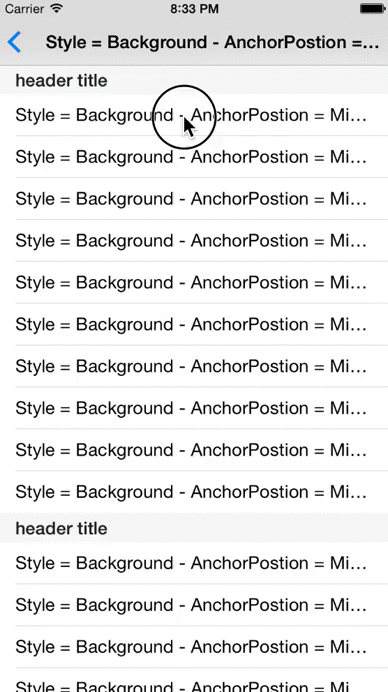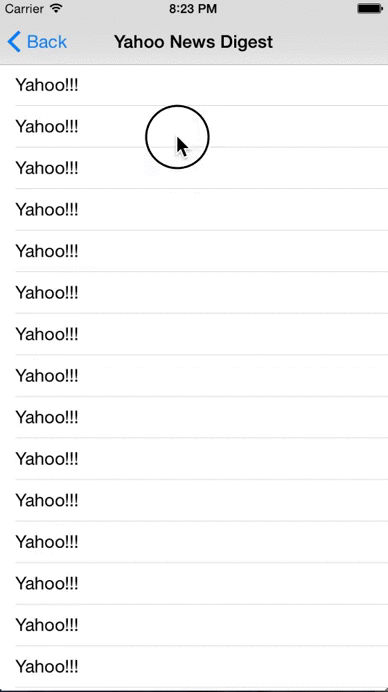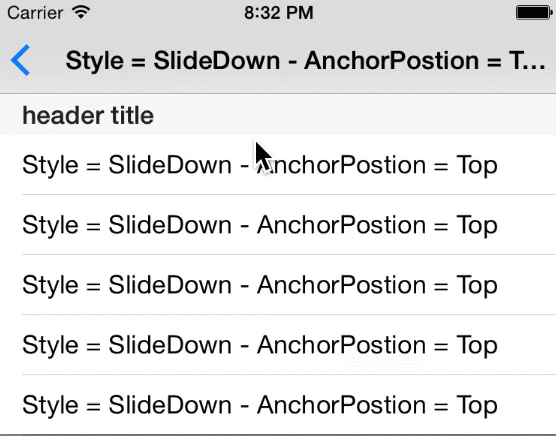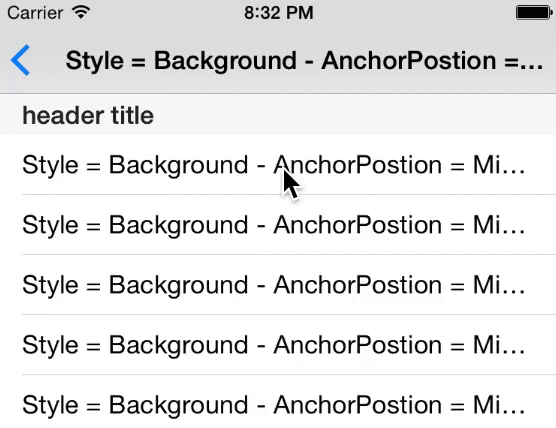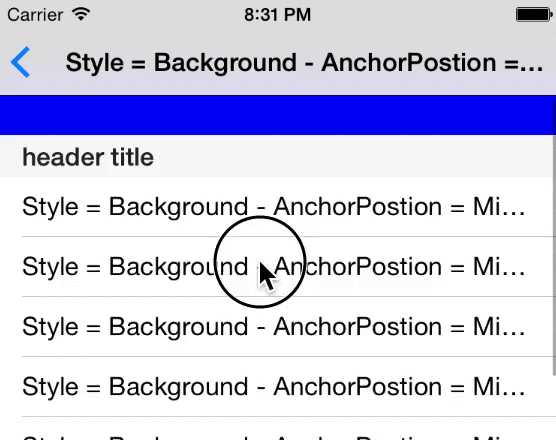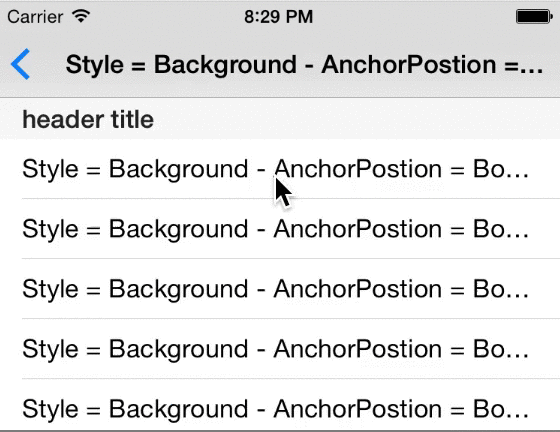JHPullToRefreshKit 1.0.1
| TestsTested | ✗ |
| LangLanguage | Obj-CObjective C |
| License | MIT |
| ReleasedLast Release | Mar 2015 |
Maintained by Jeff Hurray.
JHPullToRefreshKit 1.0.1
- By
- Jeff Hurray
Abstract base class to easily create custom pull to refresh controls
All of the above were made with less than 150 lines of code.
Why Another Pull To Refresh Library?
There are lots of PTR libraries out there but none that fit 100% of my needs. PTR controls are awesome when completed but tedious to make. I made this so I would always be able to jump right into the custom animation, and not having to worry about customization. All you have to do for my implementation is override a few abstract methods detailing height, animation duration, and what gets run each animation cycle.
My implementation provides:
- Add to a UITableView or UIScrollView in one line of code
- Customizable animations and height
- Optional use of keyframe, spring, or CALayer animations
- Anchoring of the animated view once it is pulled down past its height
- How the PTR control is presented as it is pulled down
- Exit animations
- Verbose debugging
Adding to a UIScrollView
You can add the refresh control to a scroll view in one line after you initialize it. The code in the refreshBlock will be called when the scroll view is pulled past its height.
Important: You must call endRefreshing to stop the refresh control. A good place to do this is in the callback of a network request.
-(void) viewDidLoad {
[super viewDidLoad];
...
self.myRefreshControl = [[MyRefreshControl alloc] init];
[self.myRefreshControl addToScrollView:self.tableView withRefreshBlock:^{
[self tableViewWasPulledToRefresh];
}];
...
}
-(void)tableViewWasPulledToRefresh {
[self someBigNetworkRequestWithCallback:^{
[self.myRefreshControl endRefreshing];
}];
}Subclassing JHRefreshControl
JHRefreshControl is an abstract base class, which means there are some functions you need to override. The following methods must be implemented or your app will crash. You can find a section of code to copy and paste in AbstractFunctionsCopyandPaste.txt with all the methods for your .m file.
A great example can be found in ColorChangeRefreshControl.m
Abstract Class Methods:
// sets the height of the refresh control
+(CGFloat)height;
//sets the animation duration of each animation cycle for the refresh control.
+(NSTimeInterval)animationDuration;Abstract Instance Methods:
// use this to setup the refresh control.
// put setup code here instead of init
-(void)setup;
// Used to control UI elements during scrolling
// only called while scroll view is scrolling
// not during PTR animation
-(void)handleScrollingOnAnimationView:(UIView *)animationView
withPullDistance:(CGFloat)pullDistance
pullRatio:(CGFloat)pullRatio
pullVelocity:(CGFloat)pullVelocity;- pullDistance: offset of the scroll view
- pullRatio: ratio of the offset to the height of the refresh control
-
pullVelocity: how fast the scroll view is being pulled
// Set refresh animation to correct state before a new cycle begins
// Called before each animation
-(void)setupRefreshControlForAnimationView:(UIView *)animationView;
// UI changes to be animated continuously
// until endRefreshing is called.
-(void)animationCycleForAnimationView:(UIView *)animationView;Other Useful Properties and Methods:
// manual refresh
// call in view controller
-(void)forceRefresh;
// called to end the animation
// call in view controller
-(void)endRefreshing;
// should reset UI elements here
// called after refresh control finishes and is hidden
// override in subclass
-(void)resetAnimationView:(UIView *)animationView;
// called to add a subview to the animation view
// important to only add subviews in this manner
// call in subclass to setup refresh control
-(void)addSubviewToRefreshAnimationView:(UIView *)subview;
// sets the animation delay
// override in subclass
+(NSTimeInterval)animationDelay;
//getters
@property (atomic, readonly, getter=isRefreshing) BOOL refreshing;
@property (nonatomic, readonly) CGFloat height;
@property (nonatomic, readonly) NSTimeInterval animationDuration;
@property (nonatomic, readonly) NSTimeInterval animationDelay;Under The Hood
What is this 'animation cycle' you speak of??
An animation cycle is UI code that is repeated inside an animation block. Real life examples are one spin of a yaks head on the yik yak app, or one color change on the snapchat app.
So Whats really going on??
The refresh control has a subview that runs animations. When the refresh control is pulled, it sets up the animation view for a cycle (makes sure the yaks head is at the correct start angle), and then runs the animation (spins the yaks head once.) It then checks to see if endRefreshing has been called. If it has, it exits. If it has not, it sets up and then runs the animation again (and continues this pattern until endRefreshing is called).
The process below runs continuously from the time that the scroll view is pulled to refresh to the time that endRefreshing is called.
setupRefreshControlForAnimation
-> animate [ animation cycle ]
-> completion [animation cycle finished]
-> if refreshing:
recurse (another cycle)
-> else:
refreshing ended
-> [completion animation]
-> reset animation view
Debugging
If you want to debug the above process set the JHPTR_DEBUG_FLAG to YES in JHPullToRefreshKit.h. This will provide verbose output that you can use to see what functions are being called while using a subclass of JHRefreshControl or JHLayerAnimationRefreshControl.
Customization
Variables
JHRefreshControlType
This is how the refresh control is presented when the scroll view is scrolling down (While offset < height). Must be set in initWithType:. Defaults to SlideDown if a simple init is called.
-
JHRefreshControlTypeSlideDown: the refresh control will slide down with the scroll view as it scrolls.
-
JHRefreshControlTypeBackground: the refresh control is behind the scroll view and becomes uncovered as the scroll view is scrolled down.
MyRefreshControl *refreshControl = [[MyRefreshControl alloc] initWithType:JHRefreshControlTypeSlideDown];JHRefreshControlAnchorPosition
This is how the animation view is anchored when the scroll view has been scrolled down past its height. (While offset > height). Defaults to Top.
-
JHRefreshControlAnchorPositionTop: The animation view will stick to the top.
-
JHRefreshControlAnchorPositionMiddle: The animation view will stretch as the scroll view offset increases and stick in the middle.
-
JHRefreshControlAnchorPositionBottom: The animation view will stick to the bottom.
self.anchorPosition = JHRefreshControlAnchorPositionTop;JHRefreshControlAnimationType
This determines the type of animation block that an animation cycle is run in.
- JHRefreshControlAnimationTypeDefault: Animation cycle runs inside normal [UIView animationWithDuration:...] block.
- JHRefreshControlAnimationTypeKeyFrame: Animation cycle runs inside [UIView animateKeyframesWithDuration:...] block. This means that you should call [UIView addKeyframeAnimationWithRelativeStartTime:...] inside your animationCycleForRefreshView: function.
- JHRefreshControlAnimationTypeSpring: Animation cycle runs inside [[UIView animateWithDuration: delay: usingSpringWithDamping: initialSpringVelocity:...] block.
self.animationType = JHRefreshControlAnimationTypeDefault;You can also add animation UIViewAnimationOptions for these animations.
self->animationOptions = UIViewAnimationOptionCurveEaseInOut;Exit Animations
To add an exit animation like the Yahoo news Digest example I provide, override the following function. The exit animation will be called after endRefreshing is called, and before the refresh control is resigned. Make sure to call completion() when you are done so the refresh control knows to resign!
-(void)exitAnimationForRefreshView:(UIView *)animationView withCompletion:(JHCompletionBlock)completion;
Below is an example for a Fade to black exit animation:
-(void) exitAnimationForRefreshView:(UIView *)animationView withCompletion:(JHCompletionBlock)completion {
[UIView animateWithDuration:1.0 animations:^{
self.backgroundColor = [UIColor blackColor];
self.mySubview.alpha = 0.0;
} completion:^(BOOL finished) {
[self.mySubview removeFromSuperview];
completion();
}];
}
CALayer Animations
Some animations are better done using CABasicAnimations. A good example of this is rotating >= 360 degrees. If you want to spin a view 450 degrees, UIView animation blocks will only rotate it 90 degrees. To have a refresh control that performs CABasicAnimations you must subclass JHLayerAnimationRefreshControl and override one more abstract method.
-(CALayer *) targetLayer; sets the layer that you want animated.
To add animations to this layer, simply call:
-(void)addCABasicAnimationWithKeyPath:(NSString *)keyPath fromValue:(CGFloat)fromValue toValue:(CGFloat)toValue;
A good example is in the Yahoo News Digest Example I provided. To spin the dots, I call the above function in setup.
[self addCABasicAnimationWithKeyPath:@"transform.rotation.z" fromValue:0.0 toValue:2*M_PI];This ensures that the layer I return in targetLayer will be rotated 360 degrees each animation cycle.
Note that setupRefreshControlForAnimationView: and animationCycleForAnimationView: do not need to be overriden when subclassing JHLayerAnimationRefreshControl. You can, however, override thos functions if there are other UIView animations you would like to execute.
Delegate
There are some delegate methods your view controller or scroll view can conform to.
self.myRefreshControl.delegate = self;@protocol JHRefreshControlDelegate <NSObject>
-(void)refreshControlDidStart:(JHRefreshControl *)refreshControl;
-(void)refreshControlDidEnd:(JHRefreshControl *)refreshControl;
@optional
-(void)refreshControlDidStartAnimationCycle:(JHRefreshControl *)refreshControl;
-(void)refreshControlDidEndAnimationCycle:(JHRefreshControl *)refreshControl;
@endContact Info && Contributing
Feel free to email me at [email protected]. I'd love to hear your thoughts on this, or see examples where this has been used.

